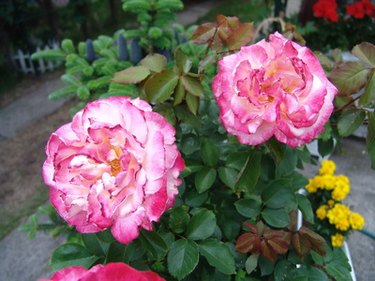
A bouquet of freshly cut roses (Rosa spp.) quickly adds beauty and a delightful fragrance to a room. Unfortunately, things can start to go downhill quickly when the flowers begin to wilt and fade. If you want to preserve your flowers and keep them looking nice as long as possible, you'll find lots of advice online and from well-intentioned friends on how to do so. Some of these home remedies, like adding sugar to the water in your vase, work quite well. Other preservation methods are merely myths.
The Sugar Theory
Video of the Day
Plants like roses use photosynthesis to create their own food, which consists primarily of carbohydrates and sugars. The plant then stores this food in its leaves and stems. When you cut a rose from the bush, it carries with it any food already stored in that particular stem. Because the flower is disconnected from the rest of the plant, however, its food supply is limited to whatever it carried with it when you made the cut.
Video of the Day
When you place your cut flower into a vase of water, it will use up any and all of the plant food available in its stem. Unfortunately, it takes the flower only a few days to use up these nutrients. After that, it starts to wilt and die. Since the death of the flower stem is caused by a lack of food, it makes sense that adding sugar to the plant's water can provide more food and prolong the flower's life.
The Sugar Reality
Sugar does provide food for cut roses, and it can lengthen the life of your flower arrangements. However, your flowers aren't the only thing that sugar feeds. Sugar also feeds bacteria, which can be a problem. Bacteria are everywhere, and no matter how meticulously you clean, you'll never completely eliminate them. When you cut flowers and place them in a vase, it takes only three hours for around 30 million bacteria to form in the water. If you add sugar, you feed this bacteria and may ultimately accelerate the demise of your blossoms.
To avoid this issue, it's important that you add both sugar and vinegar to the water in your vase. The acid in the vinegar kills some of the bacteria, allowing you to gain sugar's benefits while avoiding its pitfalls.
For best results, place 1 quart of water in your vase. Add 2 teaspoons of sugar, 2 tablespoons of white vinegar, and 1/2 teaspoon chlorine bleach to your water and stir it well. You can now place your cut flowers into the vase and enjoy them for a few days longer. You can use apple cider vinegar if you don't have white vinegar, but it will color the water in your vase. It's important to note that some flowers adversely react (or don't benefit at all) to sugar in the water, such as tulips, some types of daisies, and daffodils.
Other Tricks and Tips
Adding sugar water to your roses will lengthen their life, but so can a few other tricks. One is to cut about an inch off the bottoms of your flower stems before placing them in a vase. Cut them at a 45-degree angle so that they don't sit flat on the bottom of the vase; this can impede their ability to soak up the water. Make a fresh cut every few days.
It's also imperative that you remove any leaves that will sit in the water of your vase. Wet leaves breed bacteria, which can shorten the life of cut flowers considerably. Set your flowers in a cool, dry place away from heat sources and out of direct sunlight. For an even longer life, place them in the refrigerator overnight.
Some florists recommend adding a clear soda or clear spirits, such as vodka, to your water to preserve fresh flowers. In experiments, these two home remedies met with mixed results. The general consensus seems to be that these substances probably don't hurt, but they don't really help much either. If you desire, you can experiment with them and see what results you get. Don't bother with aspirin, copper pennies, bleach or hairspray, however. Although often touted as terrific ways to preserve flowers, these methods have all been repeatedly disproven.